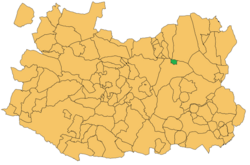


Llanos del Caudillo is a municipality in Ciudad Real, Castile-La Mancha, Spain. It has a population of 692.



Llanos del Caudillo is a municipality in Ciudad Real, Castile-La Mancha, Spain. It has a population of 692.
Llanos del Caudillo was founded by colonist families in the 1950s, [1] subsidized by the Instituto Nacional de Colonización of the Spanish government.
It was first established as an Entidad Local (Local Entity) carved out of Manzanares municipal term. [ citation needed ]
The term 'Caudillo' in its name refers to Francisco Franco, the general who ruled over Spain as a military dictator from 1939 until his death in 1975.